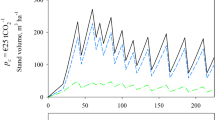Abstract
An optimization model was developed to determine the optimal harvesting strategy needed for uneven-aged mixed-species stands in the Changbai Mountain region of northeast of China. The model takes into account four variables including residual basal area (RBA), the diameter of the largest tree, harvest cycle and a constant representing the ratio of the number of trees in a given diameter class to those in the next larger diameter class (‘q’). According to model simulations, under the objective of maximizing net revenue, the optimal harvesting strategy is defined when the residual basal area equals to 19 m2 ha−1, the diameter of the largest tree equals to 44 cm, q 1.3 and the harvest cycle equals to 20 years. If the objective is to maximize the total volume yield, the optimal harvesting strategy is defined when RBA equals to 13 m2 ha−1, the diameter of the largest tree equals to 36 cm and the constant ‘q’ equals to 1.9 and the harvest cycle equals to 15 years.
Similar content being viewed by others
References
S.H. Bullard H.D. Sherali W.D. Klemperer (1985) ArticleTitleEstimating optimal thinning and rotation for mixed-species timber stands using a random search algorithm For. Sci. 31 IssueID(2) 303–315
J.H. Gove S.E. Fairweather (1992) ArticleTitleOptimizing the management of uneven-aged forest stands: a stochastic approach For. Sci. 38 623–640
Hann D.W. and Bare B.B. 1979. Uneven-age forest management: state of the art (or science?). USDA For.Serv. Gen. Tech. Rep. INT-50, 18 p.
Hao Q., Meng F.R., Zhou Y. and Wang J. (in press) ATransition Matrix Growth Model for Uneven-aged Mixed-Species Forests in Changbai Mountains, Northeastern China. New Forest.
W.B. Leak (1964) ArticleTitleAn expression of diameter distribution for unbalanceduneven-aged stands and forests For. Sci. 10 IssueID(1) 39–50
C.R. Lin J. Buongiorno (1997) ArticleTitleFixed versus variable-parameter matrix models of forest growth: the case of maple-birch forests Ecol. Model. 99 263–274 Occurrence Handle10.1016/S0304-3800(97)01960-1
C.-R. Lin J. Buongiorno M. Vasievich (1996) ArticleTitleA multi-species, density-dependent matrix growth model to predict tree diversity and income in northern hardwood stands Ecol. Model. 91 193–211 Occurrence Handle10.1016/0304-3800(95)00190-5
G.A. Mendoza A. Setyarso (1986) ArticleTitleA transition matrix forest growth model for evaluating alternative harvesting schemes in Indonesia For. Ecol. Manage. 15 219–228
S. Sánchez Oras R. Rodriguez Soalleiro (2002) ArticleTitleModelling the growth and management of mixed uneven-aged Maritime Pine-Broadleaved species forest in GaliciaNorth-western Spain Scand. J. For. Res 17 538–547 Occurrence Handle10.1080/02827580260417198
B.J. Schulte J. Buongiorno (1998) ArticleTitleEffects of uneven-aged silviculture on the stand structurespecies composition, and economic returns of loblolly pine stands For. Ecol. Mange. 111 83–101
Smith H.C. and Lamson N.I. 1982. Number of residual trees: a guide for selection harvest. Broomall, PA: Northeast. For. Exp. Stn. USDA For. Serv. Gen. Tech. Rep. NE-80, 33 p
V.C. Volin J. Buongiorno (1996) ArticleTitleEffects of alternative management regimes on forest stand structurespecies composition, and income: a model for the Italian Dolomites For. Ecol. Manag. 87 107–125
Z. Xu (1983) ArticleTitleStudy on high yield structure of Korean pine stands Res. For. Ecol. System 3 27–33
Author information
Authors and Affiliations
Corresponding author
Rights and permissions
About this article
Cite this article
Hao, Q., Meng, F., Zhou, Y. et al. Determining the optimal selective harvest strategy for mixed-species stands with a transition matrix growth model. New Forest 29, 207–219 (2005). https://doi.org/10.1007/s11056-005-5656-0
Received:
Accepted:
Issue Date:
DOI: https://doi.org/10.1007/s11056-005-5656-0




